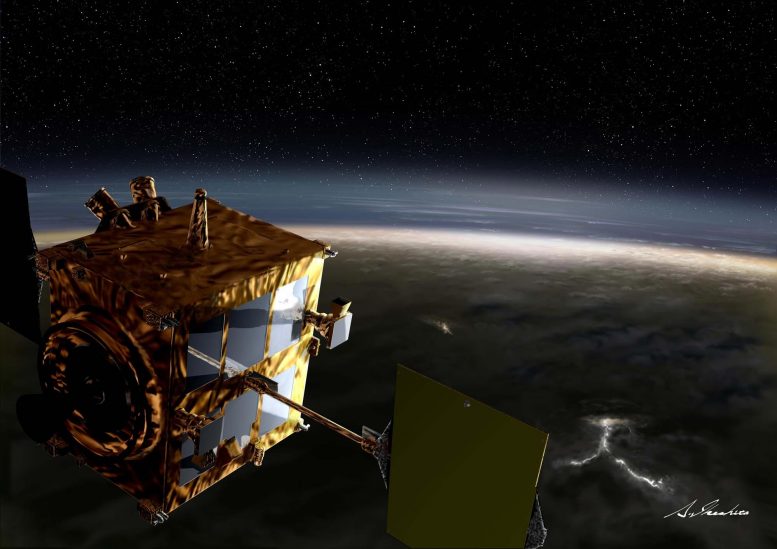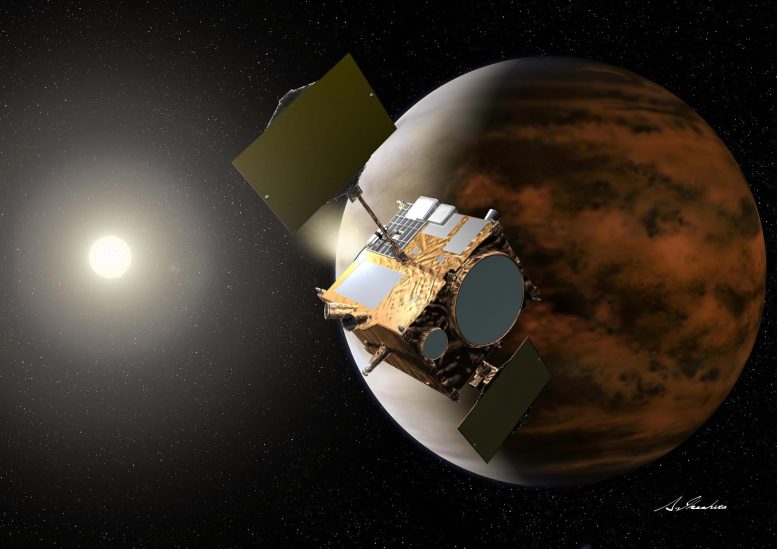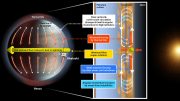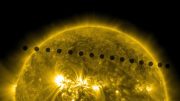
Akatsuki: surveying lightning emission in Venus’ sea of clouds and observing cloud layers on the horizon (by Akihiro Ikeshita). A conceptual image of Akatsuki observing cloud layers with lightning. Credit: JAXA
By tracking the thick clouds of Venus’ rapidly rotating atmosphere, researchers have gained new insight into the dynamic forces that drive atmospheric super-rotation — a little-understood phenomenon in which an atmosphere rotates much faster than the solid planetary body below.
Based on observations from the Japan Aerospace Exploration Agency (JAXA) spacecraft Akatsuki, which has been orbiting Venus since 2015, the study suggests that super-rotation is maintained by a combination of solar heating-driven thermal tides, planetary waves, and atmospheric turbulence.”

Conceptual image of Akatsuki having reached Venus and using reverse thrust to enter orbit around Venus (by Akihiro Ikeshita). An imaginary picture of nightside patterns visible in infrared band is superimposed on Venus. Credit: JAXA
Among the intriguing mysteries that remain for planetary atmospheres, the phenomenon of super-rotation is still a teasing problem,” writes Sebastion Lebonnois in a related Perspective. Compared to Earth, the rotation of Venus is slow — its surface takes 243 Earth days to complete one rotation. However, the Venusian atmosphere spins nearly 60 times faster, whipping around the planet once every 96 hours.
For this phenomenon to occur, a continuous redistribution of angular momentum is needed to overcome friction with the planet’s surface, although neither the source of this momentum nor how it’s maintained are known.
Using ultraviolet images and thermal infrared measurements taken by Akatsuki, Takeshi Horinouchi and colleagues tracked the motion of clouds and used them to map the planet’s winds, which provided the authors with a consistent picture of Venus’ angular momentum balance at the cloud-top level. These data allowed Horinouchi et al. to estimate the atmospheric forces sustaining the planet’s super-rotating atmosphere.
Their results show the required angular momentum is provided through thermal tides, driven by solar heating near the planet’s equator, and is opposed by planetary-scale waves (called Rossby waves) and large-scale atmospheric turbulence. “Horinouchi et al. provide an important piece of the super-rotation puzzle, that can offer a strong constraint on numerical simulations of the Venusian atmosphere,” Lebonnois writes.
References:
“Super-rotating the venusian atmosphere” by Sebastien Lebonnois at Laboratoire de Météorologie Dynamique (LMD/IPSL) in Paris, France; S. Lebonnois at Sorbonne Université in Paris, France; S. Lebonnois at ENS in Paris, France; S. Lebonnois at PSL Research University in Paris, France; S. Lebonnois at Ecole Polytechnique in Paris, France; S. Lebonnois at Institut Polytechnique de Paris in Paris, France; S. Lebonnois at CNRS in Paris, France, 24 April 2020, Science.
DOI: 10.1126/science.abb2424
“How waves and turbulence maintain the super-rotation of Venus’ atmosphere” by Takeshi Horinouchi at Hokkaido University in Sapporo, Japan; Takeshi Horinouchi; Atsushi Yamazaki; Shin-ya Murakami; Javier Peralta; Masato Nakamura; Takehiko Satoh at Japan Aerospace Exploration Agency in Sagamihara, Japan; Yoshi-Yuki Hayashi at Kobe University in Kobe, Japan; Shigeto Watanabe; Takao M. Sato at Hokkaido Information University in Ebetsu, Japan; Manabu Yamada at Chiba Institute of Technology in Narashino, Japan; Toru Kouyama at National Institute of Advanced Industrial Science and Technology in Tokyo, Japan; Makoto Taguchi; Tetsuya Fukuhara at Rikkyo University in Tokyo, Japan; Masahiro Takagi at Kyoto Sangyo University in Kyoto, Japan; Kazunori Ogohara at University of Shiga Prefecture in Hikone, Japan; Sanjay S. Limaye at University of Wisconsin-Madison in Madison, WI; Takeshi Imamura at The University of Tokyo in Kashiwa, Japan; Masato Nakamura; Takehiko Satoh at The Graduate University for Advanced Studies (SOKENDAI) in Tokyo, Japan, 24 April 2020, Science.
DOI: 10.1126/science.aaz4439









Be the first to comment on "Venus’ Atmosphere Rotates Far Faster Than Its Surface Because of Thermal Tides"